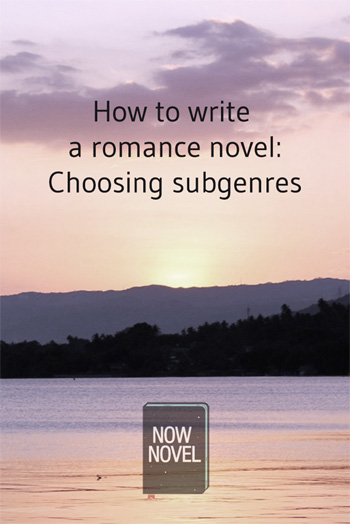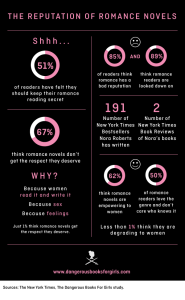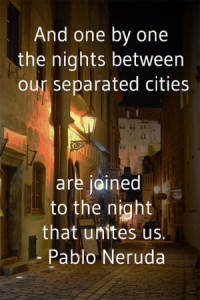If you want to learn how to write a romance novel, it’s important to familiarize yourself with genre’s many subgenres. After deciding whether you want to write category or single title romance novels, it’s time to choose your romance subgenre:
There are two different formats for romance novels. The category romance or series romance are the books put out by romance publishers such as Harlequin as part of a monthly line. They tend to be shorter at around 55,000 words, and each line has its own focus such as romantic suspense. Some writers may start out writing these types of romances and later switch to longer single-title romance novels.
Single-title romance novels comprise the rest of the genre. They may be upwards of 100,000 words and may fit in any of the below subgenres.
Who is your romance-reading audience? Understanding this is equally important to choosing your genre. It will help you decide on themes that will appeal to prospective readers. According to one survey by the Romance Writers of America, nearly a fifth of romance readers are men. Around half of all romance readers are married, are college graduates and are between the ages of 24 and 55, but many readers fall outside of these parameters as well.
Romance novel subgenres: Contemporary romance
Contemporary romance novels are set in the present or at least at some point in the past 50 or so years. Contemporary romance is harder to define than some other subgenres because it is often where books that don’t quite fit elsewhere are placed, but here are some other common elements of contemporary romance:
- The heroine is a modern, independent woman who usually has a career.
- Writers have more leeway with characters in contemporary romance novels as far as characters go – many writers include main characters in their 30s and 40s who aren’t conventionally attractive.
If your story is set in the present, consider avoiding tying it too firmly to a particular time period so that it will date more slowly.
Prominent writers in the contemporary romance genre include Jennifer Crusie and Nora Roberts.
Sizzling stories: Erotic romance
Here are some of the elements readers expect in an erotic romance:
These novels are often sexually explicit. However, they are generally not pornography as the sex must still be in the interest of developing the characters and their relationships. Erotic romance also has more leeway to explore alternative sexualities than many other subgenres.
Erotic romance tends to overlap with other fiction genres such as historical and paranormal.
This subgenre lends itself well to series writing and self-publishing.
Fifty Shades of Grey author E.L. James may currently be the best-known writer of erotic romance, but other prominent names include Sylvia Day and A.N. Roquelaure, the pen name of horror writer Anne Rice.
Otherworldly love: Fantasy romance
Mixing elements of both genres, the love story is at the core of this type of romance set in a fantasy world. Here are some other elements:
- In addition to having a plot centred on the romance, the world-building in these types of stories may sometimes be less prominent than in other types of fantasy fiction.
- These are published by both romance and fantasy imprints and also lend themselves well to series.
Jacqueline Carey and Sarah Maas are both popular writers in this genre.
A classic subgenre: Gothic romance
The gothic romance was more popular in the past than it is today, and in contemporary fiction, it overlaps with romantic suspense, paranormal romance, historical romance and even horror.
However, there is still room for gothics in the genre as evidenced by the existence of a Romance Writers of America chapter of gothic romance writers. Here are characteristics to bear in mind if you want write a romance novel in this subgenre:
- The setting is often old and remote such as a castle or crumbling family home.
- The love interest is often mysterious in some way (think of the romantic tragic hero in the classic fairytale and Disney film, Beauty and the Beast).
- Gothic romance novels are usually about uncovering dark secrets. They might also include elements such as mental illness and obsession or supernatural elements.
Contemporary writers Simone St. James and Susanne Kearsley both write historical novels with romance and gothic elements. However, there are also many other types of historical romance novels:
Back in time: Historical romance
These are books that are set primarily more than 50 or 60 years ago. Some consider World War II to be the cut-off point for a book to be considered in the “historical” category.
These novels require a lot of research although writers must decide how much they will want to foreground their research.
Popular periods and places include Victorian England, medieval Europe and colonial America.
These books might be longer than some other subgenres.
Some popular historical romance writers are Tessa Dare and Beverly Jenkins.
Inspirational/faith-based romance
Christian romance, including the popular Amish romances, are a fast-growing segment of the romance market. Here are some things to keep in mind if this is your subgenre of choice:
- The characters’ faith should be a significant element of the novel, and readers are looking for stories with a message.
- Characters may be unbelievers who convert over the course of the story, but by the end, the protagonist and the love interest should both be religious.
- These novels do not have explicit sex.
- The audience for these books tend to be conservative, devout Christians rather than more liberal denominations.
Debbie Macomber and Dee Henderson are both popular writers of inspirational romance.
Darker romance: The paranormal subgenre
The heroine in a paranormal romance might fight against monsters like vampires and werewolves or might even be a vampire or werewolf herself. Paranormal romance is similar to dark urban fantasy, but in paranormal romance, the romance is central. Some common elements of this subgenre:
- One of the characters in the central couple is often some kind of supernatural being.
- Paranormal romance tends to be set in a recognisable version of the world we live in as opposed to being a secondary-world fantasy.
- While not outright horror, these books do tend to be darker than fantasy romances.
Paranormal romances often have recurring characters and series.
Some well-known paranormal romance writers are Kelley Armstrong, J.R. Ward and Christine Feehan.
Rich historical detail: Regency romance
Set in a particular historical period, Regency romances are not a sub-category of historical romances but are their own separate sub-genre. Georgette Heyer might be considered the creator of the Regency.
Unlike historical romances, which may be action-packed and include plots driven by big events like war and revolution, Regency romances focus on society and relationships. Some typical characteristics:
- Regency romances tend to be on the short side.
- These books require extensive historical research. Readers expect accuracy.
Contemporary Regency romance writers include Carla Kelly and Emma Jensen.
Genres such as thrillers, science fiction and westerns can be blended with romance as well for crossover appeal:
Romantic suspense
At one time, romantic suspense was nearly synonymous with gothic romance, and writers such as Mary Stewart and Victoria Holt might have been included in either category. Today, romantic suspense settings and plots have been updated to resemble thrillers although the romantic interest is always central. This is a very popular genre, and both category and single-title publishers welcome romantic suspense novels. Here are some sub-genre features:
- These types of books often include many plot twists and tend to be fast-moving and tense.
- Contemporary romantic suspense novels may include plot elements like drug dealers or terrorism.
- In romantic suspense, the villain often looms as a major character who needs as much development as the central couple.
Nora Roberts and Lisa Gardner are both best-selling romantic suspense writers.
Interstellar love: Science fiction romance
Its name is fairly self-explanatory, and as is the case with other romance subgenres, the difference in science fiction with romantic elements and science fiction romance is that the romance is central to the story as opposed to being a subplot. Here are other aspects of the science fiction romance:
Written primarily to appeal to romance rather than science fiction readers, this means the world buildings and science fiction concepts may be somewhat less developed than in a science fiction novel that is not cross-genre.
On the other hand, character development in science fiction romance may be more extensive than in traditional science fiction.
Classic tropes and settings that might be considered clichéd in straight science fiction may sometimes be explored in a new way in science fiction romance.
S.E. Smith and Linnea Sinclair both write popular science fiction romances.
Falling in love on the frontier: Western romance
A subset of the historical romance, the western or frontier romance, set in the western United States, could be said to be its own subgenre. While the traditional western novel has not been a popular genre for decades, the western and frontier romance is thriving, and here are some of the common elements:
- The western or frontier romance sometimes overlaps with the Christian or inspirational romance.
- They should be handled with some delicacy (especially given how socio-politically problematic histories of human settlement are). Western romances can deal with difficult or controversial topics such as abuse and alcoholism.
- This subgenre may also lend itself to series.
- While usually a historical subgenre, the western romance can also be contemporary when it has a setting and aspects typically associated with the rural American West such as ranches and cowboys.
Debra Holland and Catherine Anderson both write western romances.
Young adult romance
I’ve included YA romance here even though it is not technically a genre and more a marketing category. YA literature is aimed roughly at the 13-to-17-year-old market although adult readers enjoy YA fiction as well. Two hugely popular but very different examples of YA romances are John Green’s The Fault in Our Stars and the Twilight series by Stephenie Meyer. Here are some things many readers look for in YA romance novels:
- Like other YA subgenres, many YA romance readers are looking for a sense of nostalgia, freshness or innocence in their reading. Often, main characters have never been in love before.
- This doesn’t mean the YA romance cannot include sexual content or even deal with difficult issues, but the sex may be less explicit than in adult novels. Sex is not a necessity.
- YA writers should try to draw on their own experience and remember what it was like to be a teen but should also spend enough time around teens or contemporary teenage culture that their romance does not feel dated.
Writers who think of romance as a narrow field or single type of book may be surprised by the range of subgenres. When you write a romance novel you have liberty to explore cross-genre work, and if you love mysteries, fantasies and other genres but wish the romantic element in those books were ramped up, you might find a home in a romance subgenre. Other aspects to consider might be whether or not you want to write series or stand-alone novels, how much research you are willing to do and how long you want your novels to be. The main rule to remember in writing romance novels is that the story must be driven by the romance.
Which romance subgenre do you prefer, and what elements do you like best about it?
For more on romance writing, read this review of author and Now Novel Romy Sommer’s 2023 novel, My Fake Italian Marriage, and an interview with Romy about its genesis.
Images from here and here



